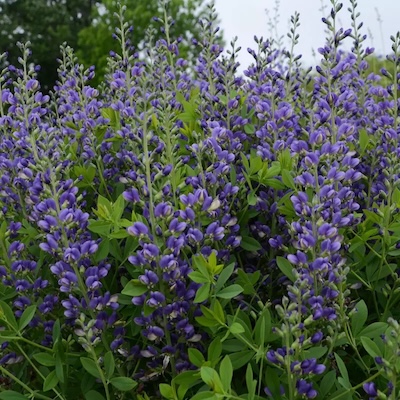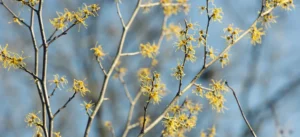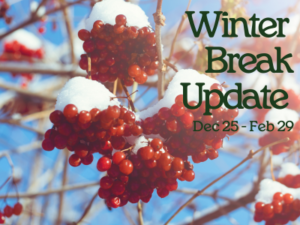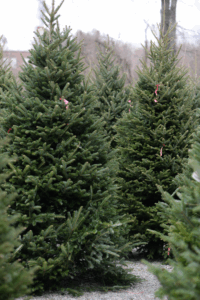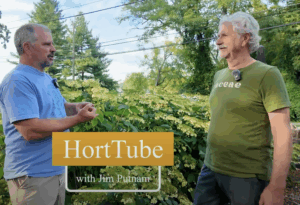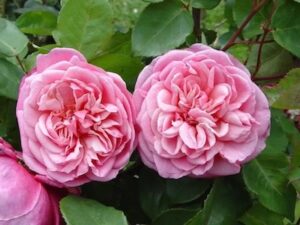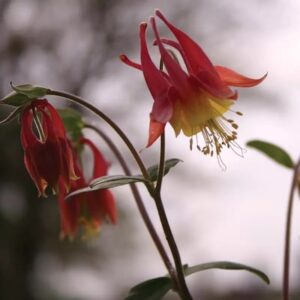Baptisia, also known as wild indigo or false indigo, is an outstanding native that deserves a prime spot in more gardens. These perennials offer the complete package of beauty and practicality. What makes Baptisia so special? It’s drought tolerant, deer resistant, requires minimal maintenance, and supports local pollinators that adore its flowers. Several of our native butterfly species also use Baptisia as a host plant, laying their eggs on the foliage so their caterpillars can feed on the leaves after hatching. With attractive flowers in a range of colors complemented by handsome foliage, these native perennials bring both ecological benefits and aesthetic charm to any garden space with ease. And from the moment its stems emerge in early spring, through its spectacular floral display, and into fall with their graceful ornamental seedpods, Baptisia delivers year-round interest.We’re wild about Baptisia, what’s not to love?
For a deep dive in the world of Baptisia, check out Mt. Cuba’s research report HERE
Now in-store!
Lemon Meringue
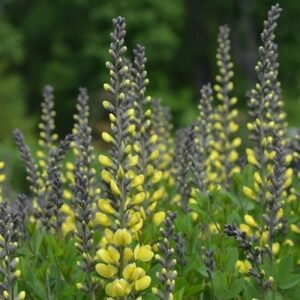
‘Lemon Meringue’ stands out as a vigorous, medium-sized selection. It creates a lush, broadly vase-shaped habit that maintains its attractive form throughout the growing season. The plant’s most spectacular feature is its three-week floral display of sunshine-yellow blossoms. Gray stems and buds provide a stunning contrast that accentuates the bright flowers. For gardeners seeking quick results from some other slower-growing Baptisia, ‘Lemon Meringue’ delivers with its impressive stem count and abundant flower production year after year.
Blueberry Sundae
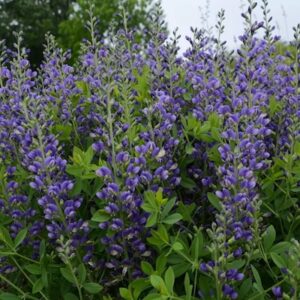
For gardeners with space constraints who still want the classic blue Baptisia experience, ‘Blueberry Sundae’ is the answer. This compact cultivar produces a significant amount of flowers while maintaining a denser growth habit. While it does spread somewhat as the season progresses, its compact form makes it ideal for smaller garden spaces. The true-blue flowers create a delightful color statement in late spring that pairs beautifully with early summer perennials and ornamental grasses.
Ivory Towers
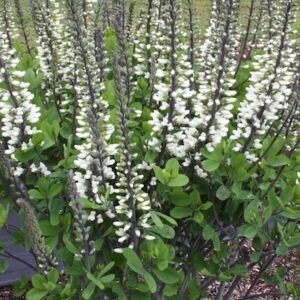
‘Ivory Towers’ has repeatedly earned its place as a standout cultivar with its elegant, upright growth habit. This selection begins the season with distinctive purple-tinged emerging stems that gradually transform as they grow. When the tall inflorescences of pure white flowers appear, it’s a spectacular display that lasts three full weeks. After flowering, large seedpods develop and persist above the foliage throughout summer and fall, extending the ornamental season. Despite being one of the larger Baptisia selections, ‘Ivory Towers’ maintains a graceful vase-shaped habit with a narrower footprint than other cultivars. The leafless lower stems create a particularly elegant silhouette that adds architectural interest to mixed borders.
Perfect Pairings
Look no further than these natives to create the perfect companion planting for your shade garden or woodland setting:
- Echinacea purpurea (Purple Coneflower) – This classic native blooms just as Baptisia finishes, providing extended color with purple-pink flowers that attract butterflies and goldfinches.
- Schizachyrium scoparium (Little Bluestem) – This native grass offers vertical structure and stunning copper-orange fall color that complements Baptisia’s attractive seedpods.
- Penstemon digitalis (Foxglove Beardtongue) – White tubular flowers bloom alongside Baptisia, attracting hummingbirds and creating a lovely texture contrast.
- Amsonia hubrichtii (Arkansas Blue Star) – Feathery foliage turns golden in fall, complementing Baptisia’s structure while providing similar drought tolerance.
- Monarda fistulosa (Wild Bergamot, Bee Balm) – Bright flowers attract abundant pollinators and bloom just after Baptisia, extending the garden’s seasonal interest.
- Solidago rugosa ‘Fireworks’ (Rough-stemmed Goldenrod) – Arching sprays of golden flowers in late summer complement Baptisia’s seedpods while supporting numerous beneficial insects.
- Aster novae-angliae (New England Aster) – Purple-blue flowers in fall create a striking backdrop for Baptisia’s structural seedheads.
- Panicum virgatum (Switchgrass) – Airy seed heads and upright form create beautiful winter interest alongside Baptisia’s architectural seedpods.
- Liatris spicata (Blazing Star) – Vertical purple flower spikes attract butterflies and create strong visual interest with Baptisia’s more rounded form.
